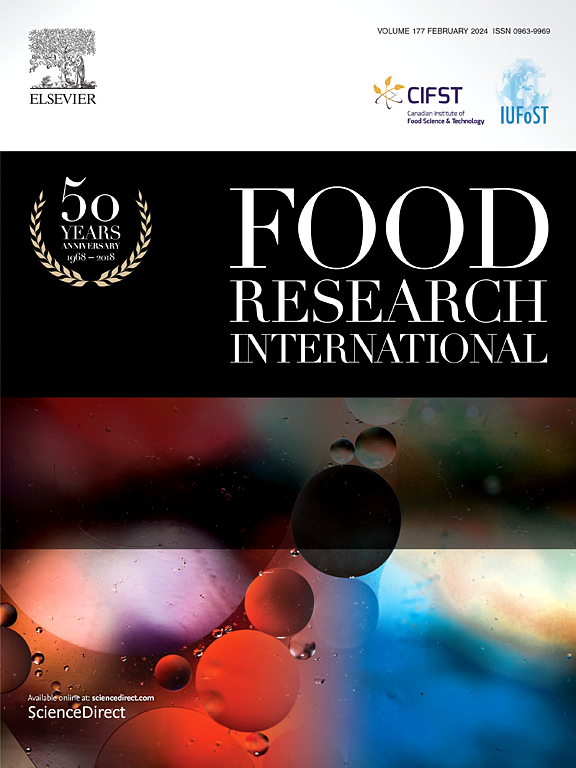Milk fat globules—A natural carrier for exogenous lipophilic bioactives
IF 7
1区 农林科学
Q1 FOOD SCIENCE & TECHNOLOGY
引用次数: 0
Abstract
Encapsulation using naturally occurring and pre-formed carriers has been of interest for food, agricultural, cosmetic, and medical applications in recent years. This study evaluated the feasibility of using milk fat globules (MFGs) as natural carriers for exogenous lipophilic bioactives. Five compounds of varying hydrophobicity (octanol/water partitioning coefficient log P 1.5–8) and total polar surface area (TPSA 25–120 Å) were selected as model bioactives. Partitioning of compounds was evaluated using fluorescence imaging, revealing that compounds preferentially localized at the membrane of the MFGs had the lowest log P (i.e., fisetin and quercetin); whereas compounds that preferentially accumulated in the MFG core were those of highest log P (i.e. eugenol, cholecalcipherol and retinyl acetate). The highest encapsulation efficiency was achieved by retinyl acetate (≥100 %, average log P = 8.0) and the lowest by fisetin (30 %, average log P = 1.5). Machine learning models were used to predict the partitioning of lipophilic molecules into MFGs. The results showed that Random Forest Regression could predict the encapsulation efficiency of the diverse compounds with higher accuracy than multiple linear regression, wherein the compound's log P, TPSA, and membrane binding energy were important features for prediction. The influence of encapsulation process conditions was also evaluated using retinyl acetate. Increased ethanol concentration, incubation time, and temperature positively affected the encapsulation of retinyl acetate. Overall, this study demonstrates that diverse lipophilic food bioactive compounds can be encapsulated in milk fat globules.

乳脂球-外源性亲脂生物活性的天然载体
近年来,使用天然存在的和预先形成的载体进行封装已经引起了食品、农业、化妆品和医疗应用的兴趣。本研究评估了乳脂球作为外源性亲脂性生物活性天然载体的可行性。选择5种不同疏水性(辛醇/水分配系数log P 1.5-8)和总极性表面积(TPSA 25-120 Å)的化合物作为模型生物活性物质。利用荧光成像评估化合物的分配,揭示优先定位于mfg膜的化合物具有最低的对数P(即非瑟酮和槲皮素);而在MFG核心优先积累的化合物是log P最高的化合物(即丁香酚、胆钙酚和视黄酯)。乙酸视黄酯包封率最高(≥100%,平均log P = 8.0),非瑟酮包封率最低(30%,平均log P = 1.5)。机器学习模型用于预测亲脂分子划分为mfg。结果表明,随机森林回归预测不同化合物包封效率的准确度高于多元线性回归,其中化合物的log P、TPSA和膜结合能是预测的重要特征。用醋酸视黄酯评价了包封工艺条件对包封效果的影响。增加乙醇浓度、培养时间和温度对乙酸视黄酯的包封有积极影响。总之,本研究表明,多种亲脂性食品生物活性化合物可以被包裹在乳脂球中。
本文章由计算机程序翻译,如有差异,请以英文原文为准。
求助全文
约1分钟内获得全文
求助全文
来源期刊

Food Research International
工程技术-食品科技
CiteScore
12.50
自引率
7.40%
发文量
1183
审稿时长
79 days
期刊介绍:
Food Research International serves as a rapid dissemination platform for significant and impactful research in food science, technology, engineering, and nutrition. The journal focuses on publishing novel, high-quality, and high-impact review papers, original research papers, and letters to the editors across various disciplines in the science and technology of food. Additionally, it follows a policy of publishing special issues on topical and emergent subjects in food research or related areas. Selected, peer-reviewed papers from scientific meetings, workshops, and conferences on the science, technology, and engineering of foods are also featured in special issues.
 求助内容:
求助内容: 应助结果提醒方式:
应助结果提醒方式:


